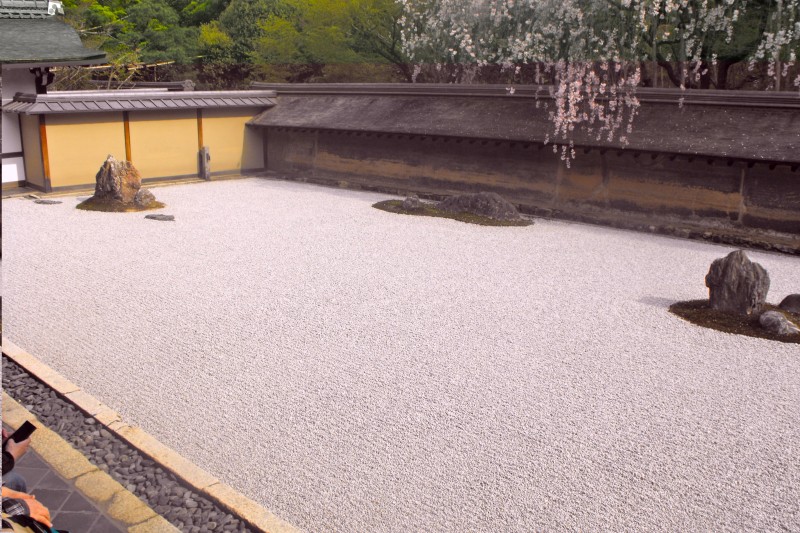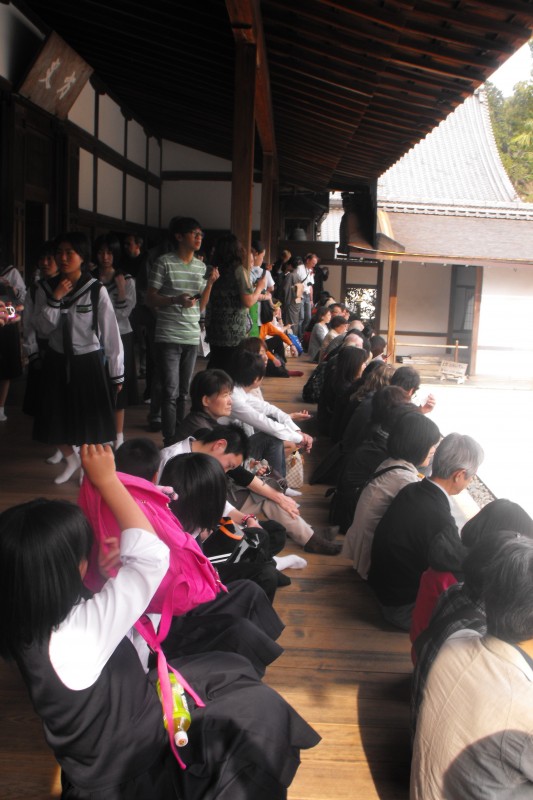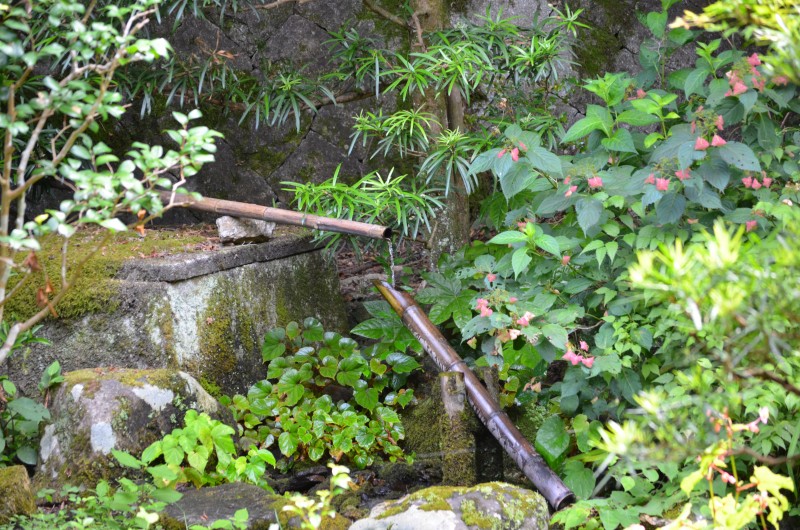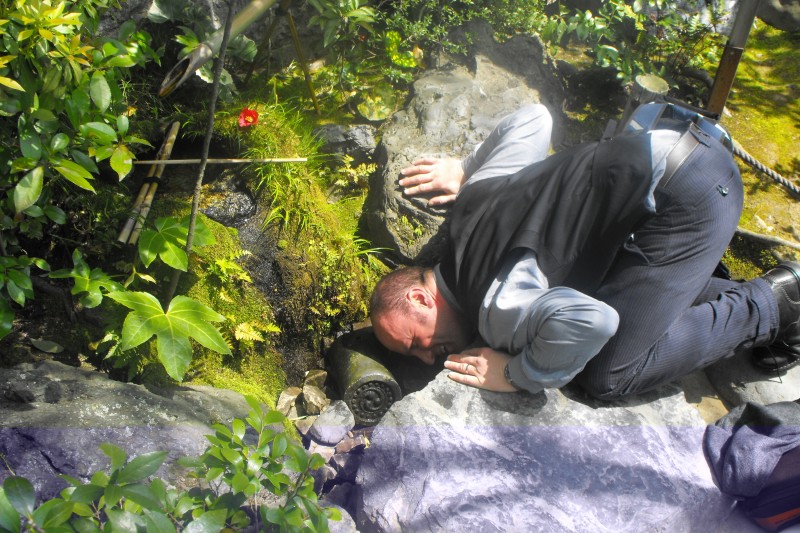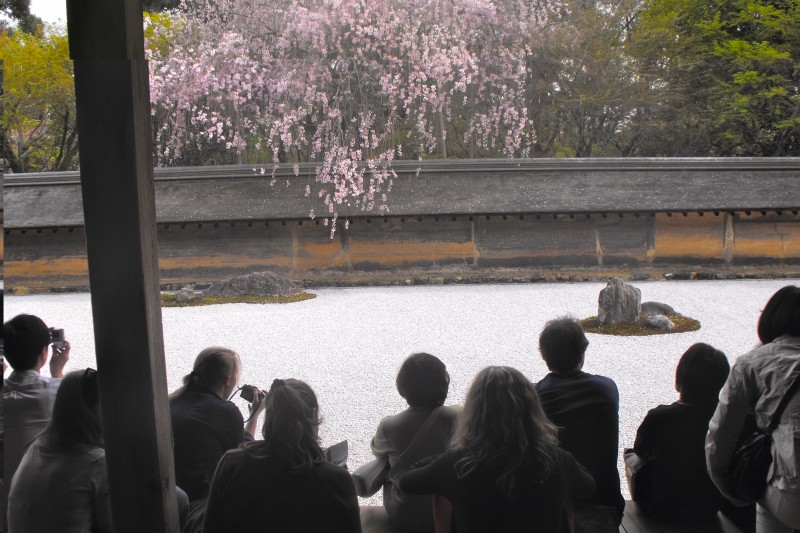My soundscape composition Sublime-sound-of-the-one-hand [Ryōan-ji] sounds out the acoustic ecology of the “quintessential … karesansui dry landscape garden” (UNESCO 1993: 41) Or, put another way, to limit “idiosyncratic and ambiguous” (BSI 2014: v) concepts spilling across interrelated disciplines, by implementing the new British International Standard’s definition of “soundscape,” the question is: how is “the acoustic environment perceived or experienced and/or understood by a person or people,” in the “context” of the karesansui dry landscape garden (BSI 2014:1)?
During my sojourn in Kyoto in April 2012, in the peak of the cherry blossom season, I seized a free afternoon to make a pilgrimage to the Muromachi period, Zen Buddhist dry landscape garden Ryōan-ji. I was in the region to develop a new cross-art-form work with landscape painter Shuji Okada, a collaborative project that coalesced around the artists’ exposure to the shoreline of Lake Biwako guided by the theoretical rubric of Shizengaku, the Japanese title of Aristotle’s Physics. (For more on that project, see here).
Visiting Ryōan-ji is a necessary excursion for every Japanese schoolchild, and it is a major feature of the international tourist trail. Its prominence is partly due to its UNESCO status as a designated “Special Site of Scenic Beauty.” There is an abundance of exquisite and auspicious karesansui in Japan, but UNESCO ossified its stake to outstanding universal value, naming Ryōan-ji one of the Historic Monuments of Ancient Kyoto within Kyoto’s World Heritage classification, citing Ryōan-ji as the “quintessential example of the karesansui dry landscape garden” (UNESCO 1993: 41).
Many carry with us a vision of Ryōan-ji, and as Rupert Cox reminds us, “seeing is a privileged sense in the Zen arts” (Cox 2003: 103). This is evidenced in the litany of Japanese visual artists who have sought to represent this particular karesansui with varying levels of abstraction, in woodblock print form Taizo Minagawa, Tadashi Nakayama, Maeda Masao, Inagaki Toshijiro Nenjiro, and Nisaburo Ito, not forgetting David Hockney’s kaleidoscopic photomontage of 1983, Walking in the Zen Garden, Ryoanji Temple.
My assumptions about the soundscape of Ryōan-ji were predicated on an experimental music composition, the eponymously named Ryoanji (Cage’s spelling) by John Cage, the first version of which premiered in 1983. As a sound artist and composer, it is hard to separate the place of Ryōan-ji from the Cage’s persona—with the D.T. Suzuki maxim quoted by Cage in his “Juilliard Lecture” (1952) echoing around my head: “men are men and mountains are mountains” (Cage 1969: 95). Cage first visited Ryōan-ji in 1962, a visit that helped reinforce his escalating association with Zen, the sensibilities of which fed into the composition Ryoanji (originally scored for oboe and percussion)—a format that Cage revisited and re-orchestrated several times. It also resulted in multiple pencil drawings that he kept returning to until his death in 1992.
Ryoanji is an oddity in Cage’s oeuvre due to its uncharacteristically programmatic nature, that is, it borrows heavily on the spatial arrangement of stones and white gravel (or sand) of this iconic karesansui. Despite these compositional methods functioning at an architectonic level, the actual soundworld of the composition concocts a sonically rarefied soundscape that feels consistent with the view. The percussion part, comprised of two distinct sounds (e.g., wood and metal) excited in unison, is predictably/unpredictably beat throughout the performance. These beats apparently represent the raked gravel forming the keynote sound for the oboe, which embodies the stones, to be sounded against.
In sharp contrast, the stones are musically characterized by long melismatic glissandi (i.e., undulating unbroken pitch sliding upward or downward). Aspects of Ryōan-ji can be found at different levels of the work. For instance, Cage traced stones (a practice that he extensively adopted in his drawings) on the score to notate the “stones” of the karesansui. The feeling with which one is imbued from such a juxtaposition of autonomous materials maintained over a long duration is that of spaciousness and clarity, effectively putting into action another of Cage’s maxims that resonates with a Zen-like approach: “The purpose of music is to sober and quiet the mind thus making us susceptible to divine influences” (Cage quoted in Kostelanetz 2005: 219).
As well as retracing the steps of Cage, I had my own (extra-musical) reasons for this homage, with a personal interest in Zen going back to my heady student days, when I had partaken in several weeklong sesshins (primarily focused on sitting zazen) with Fr. Gebhard Kohler. Kohler, building on Fr. Enomiya Lassalle’s forging of Christianity and Zen practices, demanded strict rule keeping during his sesshins in order to minimize distraction. Even during your free time when exercise was passable (but “no gymnastics”), the rules were: “as far as possible the hands are kept closed and the eyes cast downwards” (Kohler 2015). I was fascinated to consider this syncretic practice predicated on sensory privation with which I had become acquainted, with the most famous Zen site of contemplation in the world.
I sat down on the veranda of Ryōan-ji’s hōjō in the early afternoon and started to listen and record. The view was pristine and vacant. I was impressed with the beguiling raking, which is manifestly an ultra-fastidious Zen practice in itself. Despite its actual bijou dimensions, the garden played games with proportion and light. As is customary, I endeavored to count the fifteen stones of this Zen puzzle from different positions on the veranda, and I found that it is quite true that you can only see fourteen from whatever perspective. Perhaps satori was not far at hand.
But what of the prevailing soundscape and aural architecture of Ryōan-ji? How was my listening being led and what was I hearing?
This was not the spacious Ryoanji of John Cage, far from it. What I had not anticipated was Ryōan-ji joining my set of ochlophonic studies: an ongoing practice led enquiry into the auditory cultures of crowds, crowded environments, and the feeling of being crowded (from environmental psychology) through soundscapes. To date, my ochlophonic studies had come to their zenith in the restaurants, streets, and shopping malls of Hong Kong.
The keynote of Ryōan-ji from this one-off visit was the continuous hubbub of voices, primarily comprised of aloud stone counting in Japanese, quickly blending into a murky mush. The wooden hōjō was highly absorbent, and the raked gravel scattered the voices in myriad directions, so the utterances were not sharp or prominent unless close up. There was no ground-level traffic, which I am grateful for, and I heard birds singing and calling, until a helicopter split through the scene. John Urry’s “tourist gaze” (Urry 2002) was made audible with the rapid bleeping of digital cameras capturing the most photographed set of stones and raked gravel in the world. These branded bleeps (earcons), of which there was a variety, were so ubiquitous that they could have been mistaken for a checkout kiosk. This socially and sonically dense and complex soundscape reminded me on the one hand of Cage’s “inability to hear the significance of sound” (Kahn 1997: 589) and on the other Yi Fu Tuan’s writing on spaciousness:
Spaciousness is closely associated with the sense of being free. Freedom implies space; it means having the power and enough room in which to act. Being free has several levels of meaning. Fundamental is the ability to transcend the present condition. (Tuan 2003:51)
The spaciousness of Ryōan-ji that the view had profusely offered had vastly contracted due to my perception of the soundscape, and so in turn had my “sense of being free.” Such flatness had come as a surprise after the partaking of the sonic savorings in other Japanese gardens, such as the trickle of water sporadically broken by the deep woody bamboo clonkings of the shishi-odoshi (ironically devised as a noise deterrence for sika deer) and the mysteriously cavernous droplets of water resonating from the ground of the suikinkutsu.
Early the following morning, I slinked off to visit another just as auspicious but not so famous karesansui, in the South of Kyoto. Once again it was visually pristine, and I could feel a hint of wabi sabi; this time there were no crowds. However, sonic intrusion came this time in the form of a loud five-minute sequence of piped shakuhachi music heralding an instructive voiceover in Japanese that was automatically triggered by visitors entering the hōjō. Despite the sparseness of human presence, there were enough bodies passing by to make this sound sequence continuous. I am confident Junichirō Tanizaki would not have approved, having withdrawn from a planned visit to the Ishiyama Temple for the autumn moon viewing, when he learned that the Moonlight Sonata was being piped from phonograph records into the woods (Tanizaki 2001: 55).
The title I gave the soundscape composition, Sublime-sound-of-the-one-hand [Ryōan-ji], is taken from the continuation of the famous Zen kōan/original action score of “The Sound of One Hand.” It goes like this:
Master: The sublime-sound-of-the-one-hand, what is it like?
Student: The pupil immediately imitates the sound he happens to hear when sitting in front of his master. That is, if it happens to be raining outside, he imitates the sound of rain, if at that moment a bird happens to call, he imitates a bird’s call. (Hōō 1975: 50)
Listening to this temporal edit of Ryōan-ji can be an act of sociology and a form of rhythmanalysis: it tells us of the social production of space, localized proxemics, cosmopolitanisms, social dynamics, (ir)reverence for Zen aesthetics (the stones are never disturbed), and propensity for contemplation. And this edit engaged with as a composition working in tandem with this score can function as an ochlophonic listening proposition, hopefully calibrating the perception of a crowded soundscape with a spacious view, and in turn priming a sense of freedom.
Below is an except of Sublime-sound-of-the-one-hand [Ryōan-ji]. The complete version will be released by Gruenrekorder in autumn 2015.
Operating at the intersection of acoustics, sound art, soundscape studies, and urbanism, John Levack Drever’s practice represents an ongoing inquiry into the affect, perception, design, and practice of everyday environmental sound and human utterance. Drever is Professor of Acoustic Ecology and Sound Art at Goldsmiths, University of London, where he leads the Unit for Sound Practice Research. He is an Academician of the Academy of Urbanism, a Member of the Institute of Acoustics, and a Visiting Research Fellow at Seian University of Art and Design, Japan.
All photos in this post are credited to the author.
References
British Standards Institution. 2014. Acoustics — Soundscape, Part 1: Definition and conceptual framework, BS ISO 12913-1:2014.
Cage, John. 1969. A Year from Monday. Middletown, CT: Wesleyan University Press.
Cox, Rupert A. 2003. The Zen arts: An anthropological study of the culture of aesthetic form in Japan. Oxford: RoutledgeCurzon.
Kahn, Douglas. 1997. John Cage: Silence and silencing. The Musical Quarterly 81(4): 556–598.
Hōō, Hau. 1975. The sound of the one hand: 281 Zen koans with answers. Trans. Yoel Hoffman. Charlottesville: University of Virginia Press.
Kohler, Pater, G. 2015, Zen-Jou. www.zen-jou.org/ (accessed 6 July 2015).
Kostelanetz, Richard. 2005. Conversing with Cage. 2nd ed. London: Taylor & Francis.
UNESCO World Heritage Centre. 1993. Historic monuments of ancient Kyoto (Kyoto, Uji and Otsu cities). World Heritage List no. 688.
Tanizaki, Junichirō. 2001. In praise of shadows. Trans. T.J. Harper and E.G. Seidensticker. London: Vintage.
Tuan, Yi-Fu. 2003. Space and place. Minneapolis: University of Minnesota Press.
Urry, J. 2002. The tourist gaze. 2nd ed. London: Sage Publications.
Cite as: Drever, John Levack. 2015. “Sublime-sound-of-the-one-hand [Ryōan-ji],” FocaalBlog, 3 August, www.focaalblog.com/2015/08/03/john-levack-drever-sublime-sound-of-the-one-hand.
